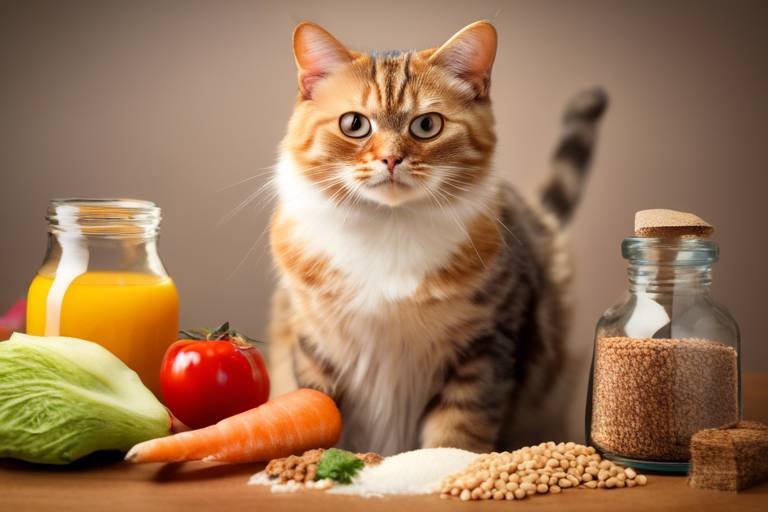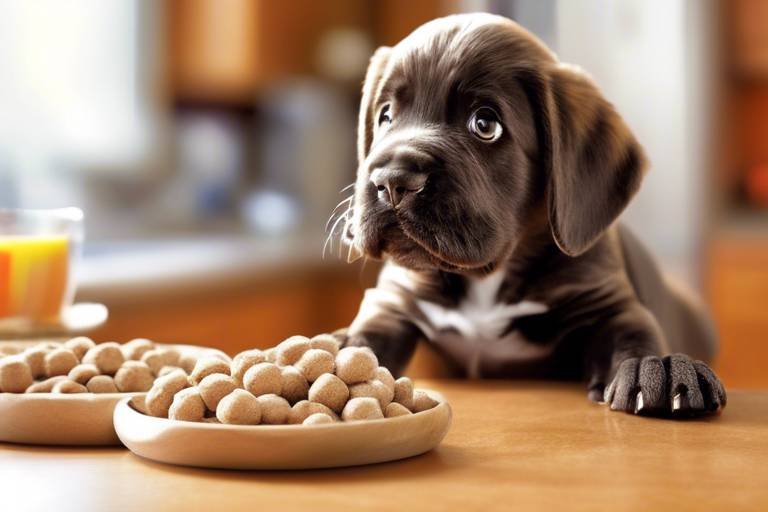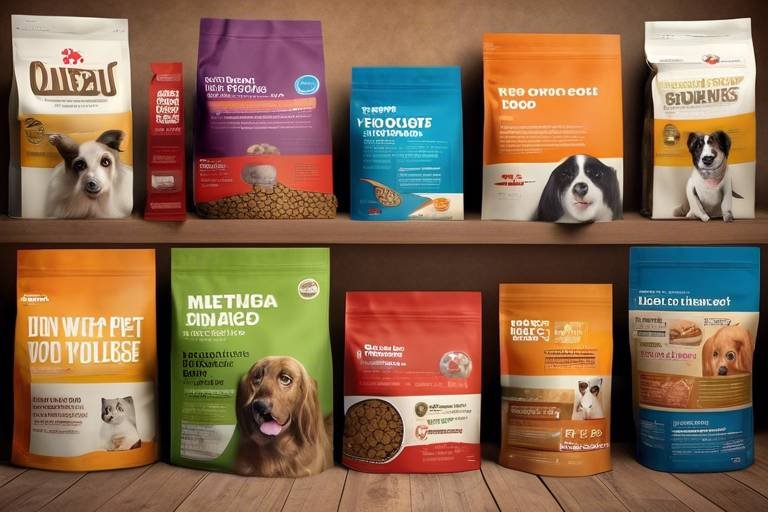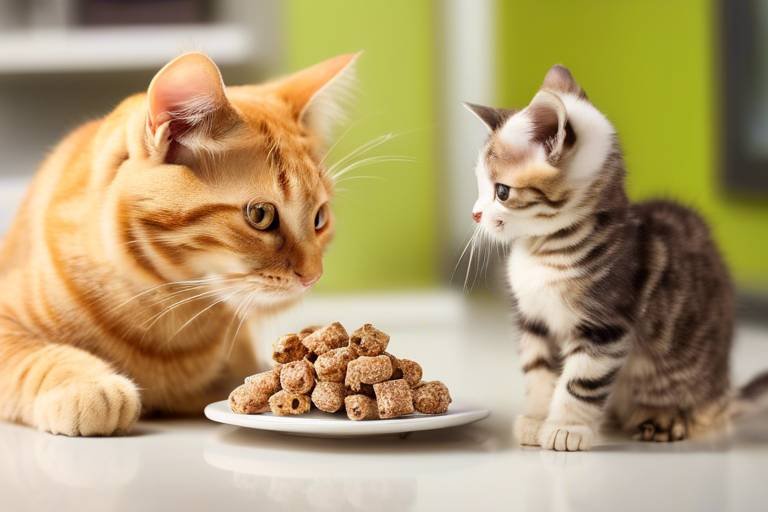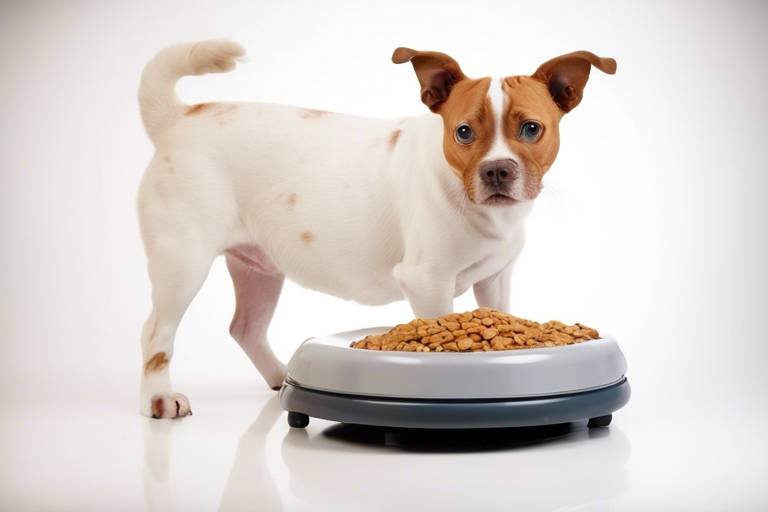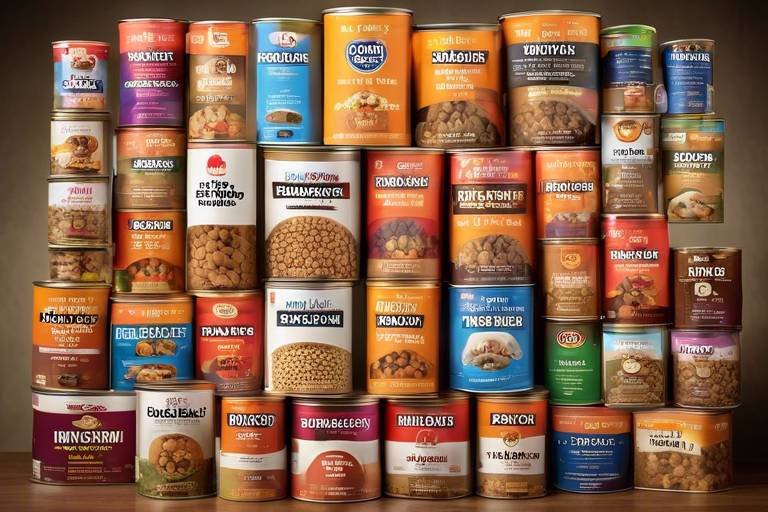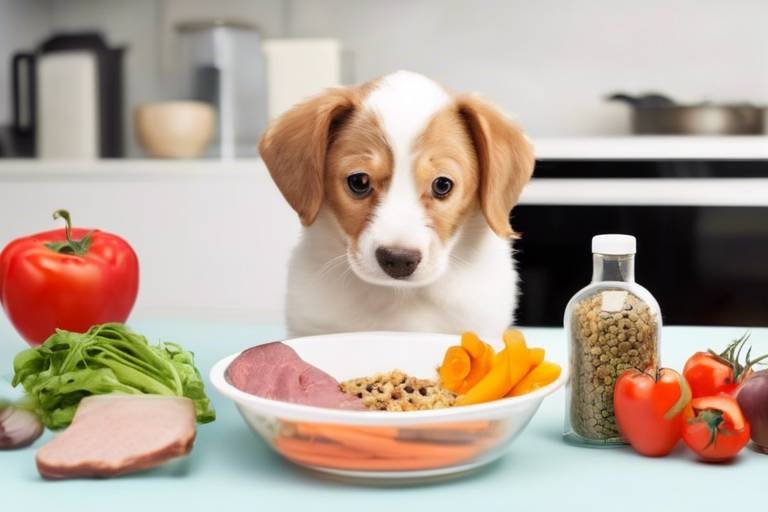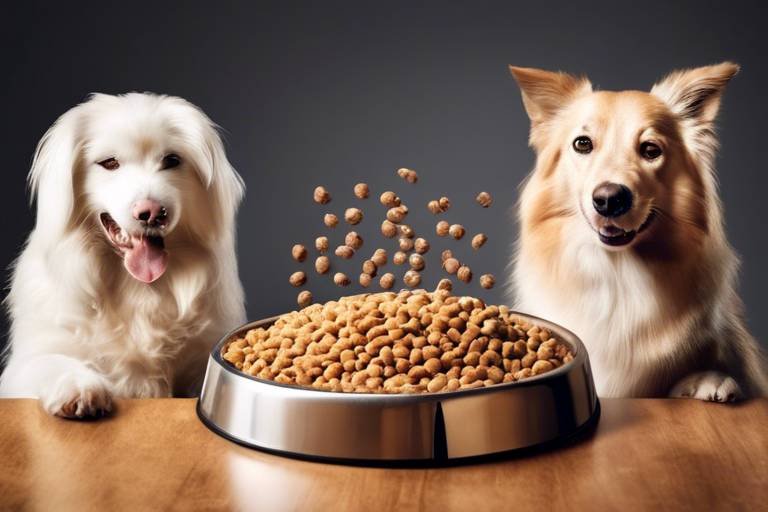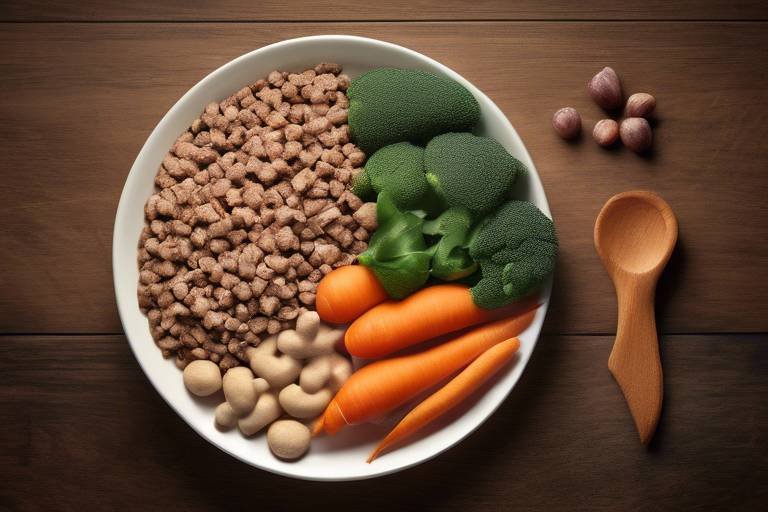How to Incorporate Leftovers into Your Pet's Meals
Have you ever looked at a plate of leftovers and thought, "What a waste!"? Well, it doesn't have to be that way, especially when it comes to your furry friends. Incorporating leftovers into your pet's meals can be a delightful way to enrich their diet while also saving you money and reducing food waste. Think of it as a culinary adventure where you get to play chef for your pet! This article will guide you through the creative ways to transform those uneaten morsels into scrumptious, nutritious dishes that your pets will love.
Imagine your dog’s wagging tail as you present them with a homemade meal crafted from last night’s roast chicken or your cat's delighted purring when they find a tasty mix of veggies and grains. Not only will you be treating them to something special, but you'll also be ensuring they get a variety of nutrients. So, let’s dive into how you can make the most of those leftovers while keeping your pets happy and healthy!
Before you start tossing leftovers into your pet's bowl, it’s crucial to understand what they actually need nutritionally. Just like us, pets require a balanced diet to thrive. This means they need a mix of proteins, carbohydrates, fats, vitamins, and minerals. For instance, dogs generally thrive on a diet rich in protein and healthy fats, while cats are obligate carnivores that need a higher protein intake.
When considering leftovers, think about how they fit into this nutritional puzzle. For example, leftover chicken is a great source of protein, while some steamed carrots can provide essential vitamins. However, not all foods are suitable for pets, and that’s where things can get tricky. Always ensure that any leftovers you plan to share are safe and beneficial for your furry friends.
Not all leftovers are created equal when it comes to our pets. Some foods can be harmful or even toxic to them. To help you navigate this culinary landscape, here are some general guidelines about what is safe to share:
- Cooked meats: Chicken, turkey, and beef are usually safe.
- Vegetables: Carrots, peas, and green beans are excellent choices.
- Fruits: Apples (without seeds), bananas, and blueberries are great treats.
On the flip side, there are foods you should absolutely avoid sharing with your pets. These include chocolate, onions, garlic, grapes, and anything seasoned with spices. Always do a quick check before introducing any new food into your pet's diet. Remember, a little knowledge goes a long way in keeping your pets safe and healthy!
Many vegetables and fruits are not just safe for pets; they are also packed with nutrients! For instance, carrots are not only crunchy and fun to chew, but they are also rich in beta-carotene, which is great for your pet’s vision and immune system. Similarly, blueberries are a superfood for pets, filled with antioxidants that can help combat aging.
When preparing these foods, make sure to wash them thoroughly and cut them into small, manageable pieces. This not only makes it easier for your pet to eat but also helps prevent any choking hazards. Always introduce new fruits and veggies gradually, monitoring your pet for any adverse reactions.
When it comes to leftovers, you might be wondering: should I serve them cooked or raw? Both methods have their pros and cons. Cooked leftovers are generally safer because cooking kills harmful bacteria, making it a better option for meats. However, some vegetables, like carrots, can lose some nutrients when cooked. It’s all about finding the right balance for your pet.
Portion control is key when adding leftovers to your pet's meals. Just because you have a plateful of food doesn’t mean you should serve it all at once! The amount you can give depends on your pet's size, breed, and dietary needs. A small dog will need significantly less than a large breed. As a rule of thumb, leftover portions should not exceed 10% of your pet's daily caloric intake. This ensures that they still get their balanced diet from regular pet food.
Transforming leftovers into delicious meals for your pets can be a fun and rewarding experience. Here are a couple of easy recipes to get you started:
1. Chicken & Veggie Stir-Fry: - Mix leftover cooked chicken with steamed carrots and peas. - Add a splash of low-sodium chicken broth for flavor. - Serve warm! 2. Fruity Yogurt Treat: - Blend leftover plain yogurt with mashed bananas and blueberries. - Freeze in ice cube trays for a refreshing treat on hot days.
When incorporating leftovers into pet meals, it’s easy to make mistakes. One common pitfall is ignoring food allergies. Just like humans, pets can have allergies to certain foods. Always be aware of your pet’s specific needs and introduce new foods slowly.
Ignoring potential food allergies can harm your pet. It’s crucial to know what your pet is allergic to and to monitor them when introducing new leftovers. If you notice any signs of discomfort, such as itching or digestive issues, consult your veterinarian immediately.
Overfeeding can lead to obesity and health issues. Balance is everything! Make sure that the leftovers complement their regular diet, rather than replace it. Keeping a close eye on portion sizes is critical for your pet's health.
Q: Can I give my pet all my leftovers?
A: Not all leftovers are safe for pets. Always check which foods are suitable and avoid harmful items like chocolate and onions.
Q: How do I know if a food is safe for my pet?
A: Research or consult with your veterinarian about specific foods before sharing them with your pet.
Q: Should I cook leftovers before giving them to my pet?
A: Cooking can make some foods safer, especially meats, but some vegetables may lose nutrients. Balance is key!
Q: How much leftover food can I give my pet?
A: Leftovers should not exceed 10% of your pet's daily caloric intake. Always adjust based on their size and dietary needs.

Understanding Pet Nutrition
Before diving into the world of leftovers, it's crucial to grasp the fundamentals of pet nutrition. Just like us, our furry friends require a balanced diet to thrive. Their nutritional needs vary based on factors such as age, weight, activity level, and health status. Understanding these needs is the first step in ensuring that any leftovers you incorporate into their meals are not only safe but also beneficial.
Pets primarily need a mix of proteins, fats, carbohydrates, vitamins, and minerals. Each of these components plays a unique role in their overall health:
- Proteins: Essential for muscle growth and repair, proteins are the building blocks of your pet's body. Good sources include cooked chicken, turkey, and certain fish.
- Fats: Healthy fats provide energy and support cell function. Ingredients like fish oil and chicken fat are great additions.
- Carbohydrates: While not as critical, carbs can be a good energy source. Cooked rice and certain vegetables can serve this purpose.
- Vitamins and Minerals: These nutrients help maintain various bodily functions. Fresh fruits and vegetables can be excellent sources.
When considering leftovers, it’s important to ensure they complement your pet's regular diet. For instance, if your pet is primarily eating dry kibble, you might want to add some moisture and flavor by mixing in some leftover cooked vegetables or meats. However, be cautious; not all human foods are suitable for pets. Foods like chocolate, onions, and grapes can be toxic, so always do your research before sharing.
Additionally, different pets have varying dietary restrictions. For example, a dog’s nutritional needs differ from those of a cat. Cats are obligate carnivores, meaning they need a diet high in animal protein, while dogs are more omnivorous. Understanding these differences is essential when incorporating leftovers into their meals.
In summary, understanding pet nutrition isn't just about knowing what to feed them; it's about creating a balanced diet that meets their unique needs. By being mindful of what goes into their bowls, you can ensure that your furry companions stay healthy and happy while enjoying the occasional leftover treat!
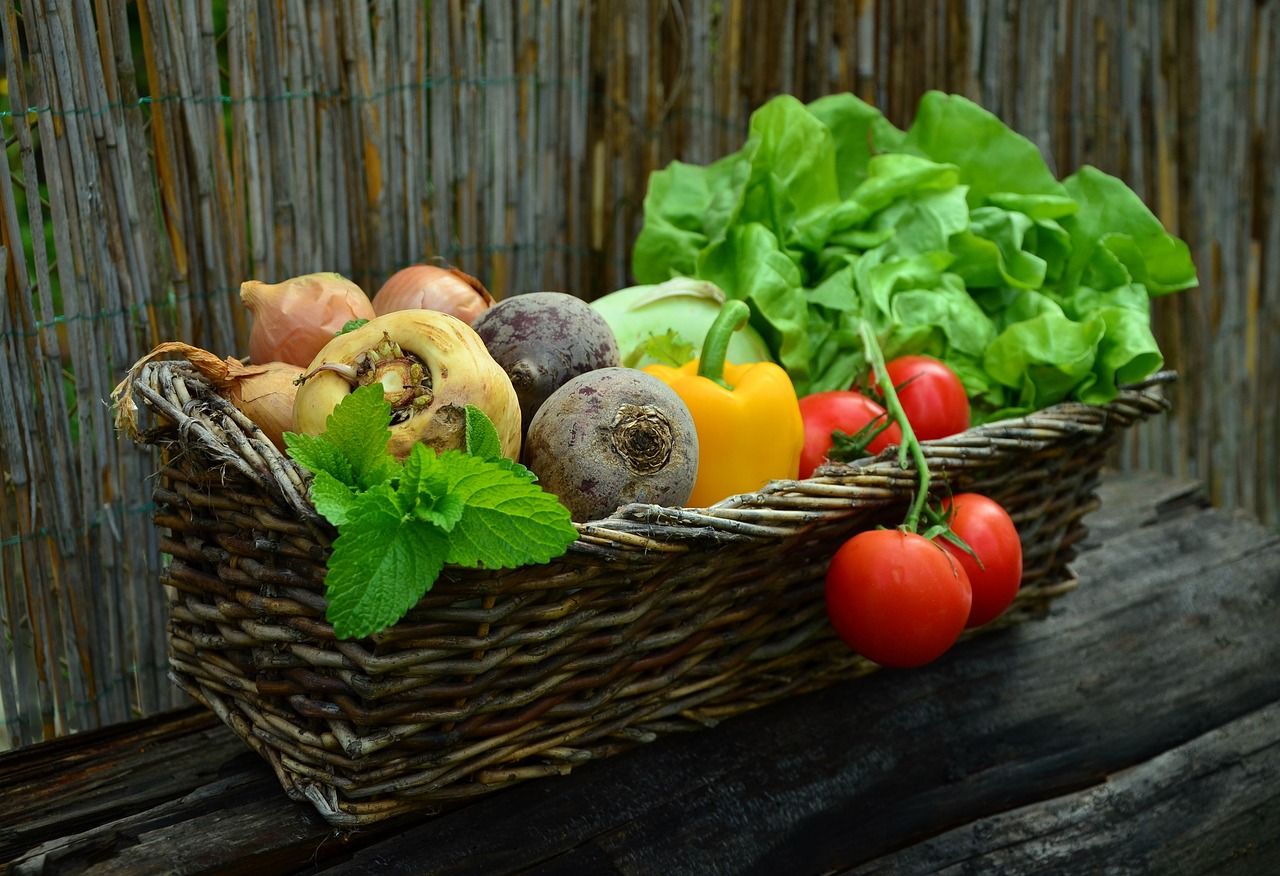
Safe Leftover Options
When it comes to sharing our meals with our furry friends, safety should always be the top priority. Not all human food is safe for pets, and understanding which leftovers are suitable can make a world of difference in keeping them healthy and happy. Think of it like a treasure hunt in your fridge: you want to find the gems that your pet can enjoy without any risks.
First, let's dive into some of the safe options that you can consider when looking to incorporate leftovers into your pet's meals. Foods like plain cooked chicken, turkey, and fish can be excellent protein sources. Just make sure they are free from any seasoning, sauces, or bones, as these can pose serious health risks. Similarly, cooked grains such as rice and quinoa are great additions that can provide energy and fiber.
But wait, it’s not just proteins and grains that can be shared! Many fruits and vegetables can be beneficial for your pets too. Here’s a quick rundown of some safe fruits and vegetables:
- Carrots: Crunchy and sweet, they’re great for dental health.
- Green beans: A low-calorie snack packed with vitamins.
- Apples: A good source of vitamins A and C, just remove the seeds!
- Blueberries: Rich in antioxidants, perfect for a tasty treat.
However, it’s crucial to remember that not all fruits and vegetables are pet-friendly. Foods like grapes, raisins, onions, and garlic can be toxic to pets. Always do your research or consult your vet before introducing something new into your pet's diet. Think of it as being a chef in your own kitchen: you wouldn’t want to serve a dish that could make someone sick!
In addition to the types of food, portion control is another aspect to consider. While it’s tempting to share a larger portion of your leftovers, moderation is key. A small amount can be a delightful treat, but too much can lead to digestive issues or obesity. As a general rule of thumb, leftovers should make up no more than 10% of your pet's daily caloric intake. This way, you ensure that they still receive a balanced diet from their regular pet food.
So, as you sift through your fridge looking for those leftover treasures, remember to keep your pet’s safety and health in mind. With a little knowledge and creativity, you can turn what would be wasted food into nutritious and enjoyable meals for your beloved pets.
Vegetables and Fruits
When it comes to incorporating leftovers into your pet's meals, are often the unsung heroes. Not only do they add a burst of flavor, but they also pack a nutritional punch that can enhance your furry friend's diet. Think of it this way: just like we need a variety of nutrients to stay healthy, our pets do too! So, why not share some of those leftover veggies and fruits sitting in your fridge? However, it's crucial to know which ones are safe and beneficial for your pets.
First, let's talk about some fantastic options you can consider. Carrots, for example, are not only crunchy and delicious but also rich in beta-carotene, which is great for your pet's vision and immune system. Green beans are another excellent choice. They are low in calories and high in fiber, making them perfect for pets that need to watch their weight. And let’s not forget about sweet potatoes! These are a powerhouse of nutrients and can be a tasty treat when cooked and mashed.
Now, while many fruits and vegetables are safe, some can be harmful. For instance, grapes and raisins are toxic to dogs, leading to serious health issues. Onions and garlic can also be dangerous, causing damage to your pet's red blood cells. Always do your research or consult your vet before introducing new foods into your pet's diet. A good rule of thumb is: if you're unsure, it's better to be safe than sorry!
When preparing these leftovers for your pet, consider how they should be served. For instance, raw carrots can be given as crunchy treats, while cooked sweet potatoes can be mashed and mixed into their regular food. The key is to keep it simple and make sure the food is cut into manageable pieces to avoid choking hazards.
Here’s a quick table to summarize some safe vegetables and fruits for your pets:
| Vegetable/Fruit | Benefits |
|---|---|
| Carrots | Rich in beta-carotene; good for vision |
| Green Beans | Low in calories; high in fiber |
| Sweet Potatoes | High in vitamins; great for digestion |
| Blueberries | Antioxidant-rich; good for brain health |
| Apples (without seeds) | High in fiber; good for heart health |
In conclusion, incorporating vegetables and fruits into your pet's meals can be a fun and healthy way to use up leftovers. Just remember to keep their safety in mind, and your pets will thank you with wagging tails and happy purrs!
Cooked vs. Raw
When it comes to feeding your pets, one of the most significant decisions you'll face is whether to offer them cooked or raw leftovers. Each option has its own set of benefits and drawbacks, and understanding these can help you make the best choice for your furry friends. Let's dive into the world of pet nutrition and explore how cooked and raw leftovers can impact your pet's health.
Cooked leftovers are often seen as a safer option for many pet owners. Cooking food can kill harmful bacteria and parasites that might be present in raw ingredients. For example, leftover chicken or beef that has been thoroughly cooked can provide your pet with essential protein without the risk of foodborne illnesses. Additionally, cooking can enhance the flavor and digestibility of certain foods, making them more appealing to your pet. However, it's crucial to ensure that any seasonings or sauces used in the cooking process are safe for pets, as many common ingredients like garlic and onions can be toxic.
On the other hand, raw leftovers can offer a range of nutritional benefits. Many proponents of raw feeding argue that it more closely resembles a pet's natural diet, particularly for carnivorous animals like cats and dogs. Raw meats, bones, and certain fruits and vegetables can provide a wealth of vitamins, minerals, and enzymes that can be lost during the cooking process. However, raw feeding comes with its own set of challenges. It's essential to source high-quality, fresh ingredients to minimize the risk of contamination. Additionally, not all pets can handle raw food well, particularly those with sensitive stomachs or weakened immune systems.
To help you weigh the pros and cons of each method, here's a quick comparison:
| Aspect | Cooked | Raw |
|---|---|---|
| Safety | Generally safer; kills harmful bacteria | Higher risk of contamination if not handled properly |
| Digestibility | Often easier to digest | Can be harder to digest for some pets |
| Nutritional Value | May lose some nutrients in cooking | Retains more vitamins and enzymes |
| Flavor | Can be enhanced with safe seasonings | May be less appealing to some pets |
Ultimately, the choice between cooked and raw leftovers depends on your pet's individual needs, preferences, and health conditions. It's always a good idea to consult with your veterinarian before making significant changes to your pet's diet. They can provide tailored advice based on your pet's unique situation, ensuring that you make informed decisions that promote their health and happiness.
- Can I mix cooked and raw food? Yes, but it's essential to introduce new foods gradually and monitor your pet's reaction.
- What leftovers should I avoid? Foods like chocolate, grapes, onions, and garlic are toxic to pets and should never be fed.
- How do I know if my pet prefers cooked or raw? Observe their eating habits and consult with your vet for personalized recommendations.
Portion Control
When it comes to incorporating leftovers into your pet's meals, is absolutely crucial. Just like us, our furry friends can easily overindulge, leading to unwanted weight gain and health issues. Imagine serving a heaping plate of spaghetti to a tiny Chihuahua—sounds like a recipe for disaster, right? Well, it’s the same with leftovers. You want to ensure that what you serve is not only delightful but also safe and appropriate for their size and dietary needs.
To get started, it’s essential to understand your pet’s ideal daily caloric intake. This varies based on factors like their age, weight, activity level, and breed. For instance, a playful Labrador will require more calories than a sedentary Persian cat. A handy rule of thumb is to consult with your veterinarian to determine the right caloric amount for your pet. Once you have that figure, you can begin to calculate how much of those calories can come from leftovers.
Here’s a simple way to break it down: if your pet’s daily caloric intake is 400 calories, you might want to allocate about 10-15% of that for leftovers. This means you can safely introduce around 40-60 calories of leftover food into their meals without throwing their diet off balance. But how do you measure that? A kitchen scale can be your best friend here, allowing you to weigh out portions accurately.
Another tip is to keep a food diary for your pet. This not only helps you track their regular meals but also makes it easier to see how much of their diet consists of leftovers. You can create a simple table to monitor their intake:
| Date | Regular Food (Calories) | Leftovers (Calories) | Total (Calories) |
|---|---|---|---|
| 01/01/2023 | 350 | 50 | 400 |
| 01/02/2023 | 360 | 40 | 400 |
By maintaining this record, you can easily adjust portions as needed and ensure your pet maintains a healthy weight. Remember, consistency is key! When you create a routine around their meals, it not only helps with their digestion but also keeps them feeling satisfied and happy.
Lastly, always observe your pet’s reaction to new foods. If they seem to enjoy the leftovers and have no adverse reactions, you can gradually increase the variety while keeping a close eye on their overall portion sizes. If you notice any changes in their behavior or health, don’t hesitate to consult your vet for advice. After all, the goal is to make mealtime a joyful experience for your beloved pet while keeping their health in check!
Creative Recipes for Leftovers
Transforming your pet's leftovers into delicious meals can be a delightful experience, both for you and your furry friend. Not only does it help reduce food waste, but it also allows you to whip up some exciting dishes that your pet will love. Here are a few creative recipes that incorporate common leftovers, ensuring your pet enjoys nutritious and tasty meals.
One of the simplest recipes you can try is a Vegetable and Rice Medley. If you have leftover cooked rice and some veggies like carrots, peas, or green beans, you can create a wholesome dish. Just mix the rice with the chopped vegetables, add a splash of low-sodium chicken broth for flavor, and heat it up. This dish is not only tasty but also packed with vitamins and minerals that your pet needs.
Another fantastic option is Meat Scramble. If you have leftover cooked chicken, beef, or turkey, chop it into small pieces and sauté it with some scrambled eggs. You can also add in some spinach or kale for an extra nutrient boost. This protein-packed meal is sure to make your pet's tail wag with joy!
If your pet enjoys a bit of sweetness, consider making a Fruit and Yogurt Delight. Take any leftover fruits like bananas, apples, or berries, and mix them with plain, unsweetened yogurt. This refreshing treat is not only delicious but also great for your pet's digestive health due to the probiotics in yogurt. Just be sure to avoid any fruits that are toxic to pets, such as grapes or citrus fruits.
For those chilly days, a Leftover Stew can be a warming and filling option. Combine leftover meats, vegetables, and some broth in a pot. Let it simmer until everything is heated through, and your pet will enjoy a comforting bowl of stew. This recipe is highly customizable, so feel free to add in any safe leftovers you have on hand.
Lastly, don't forget about Homemade Treats! If you have leftover pumpkin puree or sweet potato, you can mix it with some oats and peanut butter to create a dough. Roll it out, cut it into shapes, and bake until golden. Your pet will love these chewy, nutritious treats, and you can feel good knowing exactly what’s in them.
Incorporating leftovers into your pet's meals is not just about creativity; it's about ensuring they receive a balanced diet while enjoying the flavors they love. As you explore these recipes, remember to keep an eye on portion sizes and your pet's individual dietary needs. Happy cooking!
Q: Can I feed my pet any leftover food?
A: Not all leftovers are safe for pets. It's important to know which foods are safe and which should be avoided, such as chocolate, onions, and grapes.
Q: How do I know if my pet has a food allergy?
A: Signs of food allergies can include itching, digestive issues, or unusual behavior. If you suspect an allergy, consult your veterinarian for guidance.
Q: Is it okay to feed my pet leftovers every day?
A: While leftovers can be a great addition to your pet's diet, they should not replace their regular pet food. Balance is key to maintaining their health.
Q: How can I ensure the leftovers are safe for my pet?
A: Always research any new food before introducing it to your pet. Consult with your vet if you're unsure about specific leftovers.

Common Mistakes to Avoid
When it comes to incorporating leftovers into your pet's meals, it’s all too easy to stumble into a few common traps. First off, one of the biggest mistakes pet owners make is ignoring allergies. Just like humans, pets can have food sensitivities or allergies that can lead to discomfort or serious health issues. Before introducing any new leftovers, it’s crucial to know what your pet can and cannot eat. For instance, while some dogs can munch on carrots without a second thought, others might react poorly to them. Always start with a small amount of any new food and watch for any signs of distress.
Another frequent pitfall is overfeeding leftovers. It’s tempting to share all your delicious scraps with your furry friend, but remember that leftovers are meant to be a supplement to their regular diet, not a replacement. Overindulgence can lead to obesity, which brings along a host of health problems such as diabetes and joint issues. To avoid this, you should maintain a balanced diet. A good rule of thumb is to ensure that leftovers make up no more than 10% of your pet’s daily caloric intake. If you're unsure about the right portion sizes, consult your veterinarian for tailored advice.
Additionally, many pet owners fail to consider the nutritional value of the leftovers they are feeding their pets. Not all human food is created equal, and while some leftovers might be safe, they might not provide the necessary nutrients that your pet needs. For example, while a little bit of cooked chicken is great, a leftover slice of pizza loaded with cheese and spices is not. To keep your pet healthy, aim for leftovers that are rich in protein, healthy fats, and essential vitamins. You might want to keep a list of safe and nutritious leftovers handy, so you can make informed decisions on what to share.
To help you avoid these common mistakes, here’s a quick reference table highlighting what to watch out for:
| Mistake | Description | Tip to Avoid |
|---|---|---|
| Ignoring Allergies | Not recognizing food sensitivities can lead to health issues. | Research foods and start with small portions. |
| Overfeeding Leftovers | Feeding too much can cause obesity and related health problems. | Limit leftovers to 10% of daily intake. |
| Neglecting Nutritional Value | Not all human food is suitable for pets. | Focus on nutrient-rich leftovers. |
By being mindful of these common mistakes, you can create a more enjoyable and safe mealtime experience for your pet. Remember, your furry friend relies on you to make the best choices for their health and happiness. So, next time you’re about to share your leftovers, take a moment to think about what’s on your plate and how it can impact your pet.
Q: Can I give my pet all types of leftovers?
A: No, not all leftovers are safe for pets. Foods like chocolate, onions, and grapes are toxic to pets. Always check which foods are safe before sharing.
Q: How do I know if my pet has a food allergy?
A: Symptoms of food allergies can include itching, gastrointestinal upset, or ear infections. If you suspect an allergy, consult your veterinarian for proper testing.
Q: What should I do if my pet eats something harmful?
A: If your pet consumes something toxic, contact your veterinarian or an emergency animal poison control hotline immediately.
Q: Are there any leftovers I should avoid completely?
A: Yes, avoid giving pets foods like chocolate, onions, garlic, grapes, and anything with high sugar or salt content.
Q: How can I balance my pet's diet with leftovers?
A: It’s important to ensure that leftovers are a small portion of their overall diet. Consult with your vet to determine the right balance based on your pet’s size and health needs.
Ignoring Allergies
When it comes to our furry friends, can be a serious mistake that could lead to discomfort or even health complications. Just like humans, pets can suffer from food allergies, and it's essential to be aware of what they can and cannot eat. If your pet has shown signs of food allergies, such as itching, digestive issues, or unusual behavior, it’s crucial to consult with your veterinarian before introducing any new leftovers into their diet.
Many pet owners might think that sharing their leftover meals is harmless, but some common human foods can be problematic. For instance, ingredients like garlic, onions, and chocolate are toxic to dogs and cats. Even seemingly harmless foods can cause reactions in sensitive pets. To avoid these pitfalls, you should always research and know your pet's specific dietary restrictions.
Additionally, when you decide to incorporate leftovers, it’s best to introduce them gradually. This way, you can monitor your pet for any signs of an allergic reaction. If your pet experiences any adverse effects, it’s essential to stop feeding that particular food immediately. Keeping a food diary can also be a helpful tool. By noting what your pet eats and any reactions they have, you can identify potential allergens more easily.
Here’s a quick guide to some common pet allergens:
| Common Allergens | Symptoms |
|---|---|
| Beef | Itching, digestive upset |
| Dairy | Vomiting, diarrhea |
| Wheat | Skin issues, ear infections |
| Chicken | Itching, inflammation |
Incorporating leftovers into your pet's meals can be a fun way to reduce waste and provide variety in their diet, but it’s essential to do so with caution. Always prioritize your pet's health by being informed and attentive to their needs. Remember, the goal is to create a happy and healthy mealtime experience for your beloved companion!
- Can all pets eat the same leftovers? - No, different pets have different dietary needs. Always check what is safe for your specific pet.
- How can I tell if my pet has food allergies? - Look for symptoms like itching, digestive issues, or unusual behavior, and consult your vet.
- What should I do if I suspect my pet has a food allergy? - Stop feeding them the suspected food and consult your veterinarian for advice.
Overfeeding Leftovers
When it comes to our furry friends, we often want to spoil them with delicious food, especially if it’s something we enjoyed ourselves. However, can lead to serious health issues for your pet. Just like humans, pets can suffer from obesity, digestive problems, and other health complications if they consume too much food, even if it's nutritious. It's essential to strike a balance between treating them to tasty leftovers and maintaining their overall health.
So, how do we determine the right amount of leftovers for our pets? First, consider their size, age, and activity level. For instance, a small dog or a sedentary cat may require fewer calories than a large, active dog. One way to keep track of their dietary needs is by consulting your veterinarian. They can provide tailored advice on how much food your pet should consume daily, including any leftovers you might want to share.
To help you visualize portion control, here’s a simple table that outlines recommended daily calorie intake based on your pet's weight:
| Pet Weight (lbs) | Daily Caloric Needs (kcal) |
|---|---|
| 5-10 | 200-400 |
| 11-20 | 400-800 |
| 21-40 | 800-1600 |
| 41-60 | 1600-2400 |
When incorporating leftovers, it’s best to think of them as a supplement to your pet's regular diet rather than a replacement. If you're adding leftovers to their meals, consider reducing the amount of their usual food to prevent overfeeding. For example, if you give your dog a cup of leftover chicken, you might want to cut back on their kibble for that meal. This way, they can enjoy the flavors of your leftovers without exceeding their caloric needs.
Another common mistake is assuming that all leftovers are healthy. While some foods are safe and nutritious, others can be harmful or even toxic to pets. Foods like onions, garlic, chocolate, and grapes should always be avoided. Make sure to do your research on what’s safe for your pet before sharing any leftovers. Additionally, keep an eye on their weight and overall health. If you notice any sudden changes, such as weight gain or lethargy, it might be time to reevaluate their diet.
In conclusion, while sharing leftovers with your pets can be a delightful experience, it's crucial to be mindful of portion control. By understanding their nutritional needs and being cautious about the types of leftovers you share, you can ensure that mealtime remains a joyous occasion without compromising their health.
Frequently Asked Questions
- Can I feed my pet any leftovers from my meals?
No, not all leftovers are safe for pets. It's essential to know which foods are suitable and which should be avoided. For example, while plain cooked chicken is fine, foods with spices, garlic, or onions can be harmful.
- What types of vegetables and fruits can I share with my pet?
Many vegetables and fruits are great for pets! Carrots, green beans, and apples (without seeds) are nutritious options. Just make sure to introduce them gradually and watch for any adverse reactions.
- Should I feed my pet cooked or raw leftovers?
Both cooked and raw leftovers can be beneficial, but it depends on the food type. Cooked food is often easier to digest, while some pets thrive on raw diets. Always consult your vet for personalized advice!
- How do I control portions when adding leftovers to my pet's meals?
Portion control is key! A good rule of thumb is to make leftovers no more than 10-15% of your pet's daily caloric intake. Adjust based on their size, activity level, and overall health.
- What are some common mistakes to avoid when feeding leftovers?
Common mistakes include ignoring food allergies and overfeeding. Always check for known allergies and ensure that leftovers complement your pet's regular diet without leading to excess calorie intake.
- How can I tell if my pet is allergic to certain foods?
Watch for symptoms like itching, digestive upset, or unusual behavior after introducing new foods. If you suspect an allergy, consult your veterinarian for proper testing and advice.
- Is it safe to feed my pet leftovers every day?
While it's okay to incorporate leftovers occasionally, they shouldn't replace your pet's main diet. Balance is crucial to ensure they receive all necessary nutrients.


